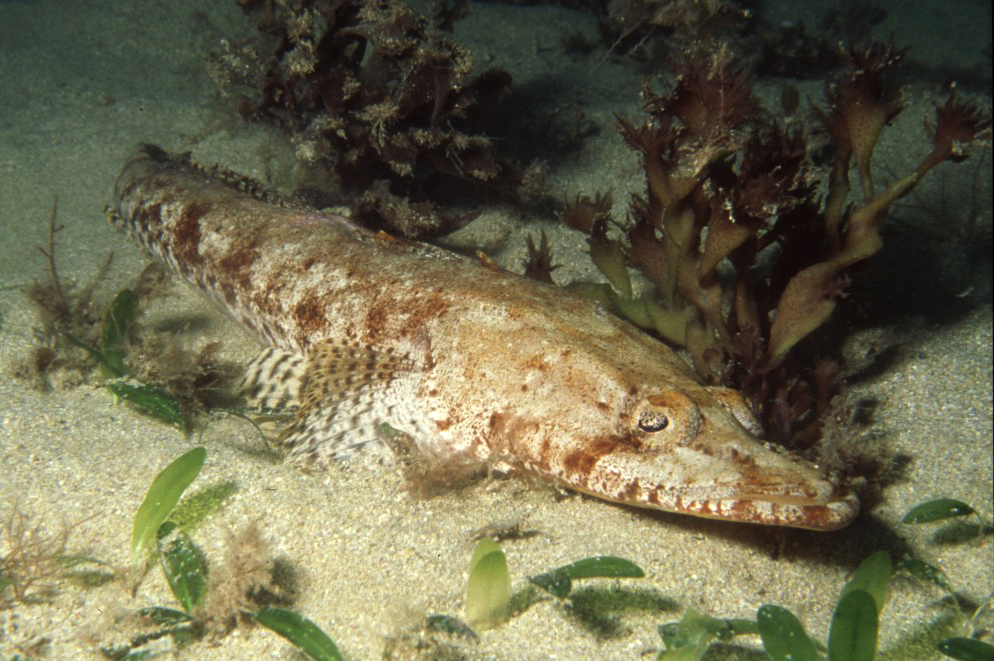Longhead Flathead, Leviprora inops (Jenyns 1840)

A Longhead Flathead, Levipora inops, in South Australia. Source: David Muirhead / Marine Life Society of South Australia (MLSSA). License: CC by Attribution-NonCommercial-ShareAlike
Longhead Flathead, Leviprora inops (Jenyns 1840)
More Info
|
Distribution |
Inshore waters of southern Australia from the Gulf St. Vincent and south of Kangaroo Island, South Australia, to the Swan River, Western Australia, at depths to about 20 m. Inhabits shallow coastal waters, commonly on rocky reefs with rich vegetation; juveniles are often found buried in sand in seagrass areas. |
|
Features |
Dorsal fin I, VII-VIII, 12; Anal fin 11-13; Caudal fin 11-12 (branched rays); Pectoral fin 18-19; Pelvic fin I, 5; Lateral line scales (pored) 51-54; Gill rakers 1 + 5-6 = 6-7. Body elongate, slightly depressed. Head very long (length ~40% SL), strongly depressed, relatively smooth with low ridges; eyes moderately large (16-18% HL), iris lappet long fringed; mouth very large with very small teeth in a broad band on each jaw and two separate patches on vomer; two small, inconspicuous preopercular spines at angle of preopercle. Scales small, finely ctenoid, covering body and most of head behind eyes; lateral line nearly straight; lateral line scales subequal to adjacent scales on side, lacking spines or ridges along entire length of lateral line. First dorsal fin spinous with short base, first spine very short, detached, middle spines tall. Second dorsal fin with moderately long base, rays nearly as long as longest first dorsal spines. Anal fin similar in shape, and opposite. Caudal fin rounded. Pectoral fins moderately small. Pelvic fins long, based below centre of pectoral fins. |
|
Size |
Maximum length at least 61 cm; maximum weight at least 2.5 kg. |
|
Colour |
Sandy to pinkish brown dorsally with irregular spots and blotches (becomes dark brown after capture); pale ventrally. Fins covered with dark and light spots forming indistinct lines; first dorsal fin with oblique brown band on distal half. |
|
Feeding |
Primarily piscivorous, also large benthic crustaceans. |
|
Fisheries |
May be caught incidentally in trawls and nets. |
|
Similar Species |
Differs from the Semi-armed Flathead, Leviprora semermis, in the number of pectoral-fin rays (18–19 in L. inops vs. 20–21 in L. semermis), the preocular spine (absent vs. present), fleshy sensory tubes on the cheek region (absent vs. developed), number of ducts of pored scales in the lateral line (one vs. two) and ratio of orbital diameter/interorbital width (2.3–4.7 vs. 1.5–2.8, both tending to decrease with growth). |
|
Species Citation |
Platycephalus inops Jenyns, 1840, Zool. Voy. ‘Beagle', Fish: 33. Type locality: King George Sound, Western Australia. |
|
Author |
CSIRO Marine & Atmospheric Research & Bray, D.J. 2020 |
|
Resources |
Longhead Flathead, Leviprora inops (Jenyns 1840)
References
Gomon, M.F. 2008. Family Platycephalidae. pp. 515-521 in Gomon, M.F., Bray, D.J. & Kuiter, R.H. (eds). Fishes of Australia's Southern Coast. Sydney : Reed New Holland 928 pp. (in part)
Hutchins, J.B. 1994. A survey of the nearshore reef fish fauna of Western Australia's west and south coasts — The Leeuwin Province. Records of the Western Australian Museum, Supplement 46: 1-66 figs 1-6
Hutchins, J.B. & Swainston, R. 1986. Sea Fishes of Southern Australia. Complete field guide for anglers and divers. Perth : Swainston Publishing 180 pp. (in part)
Imamura, H. 1996. Phylogeny of the family Platycephalidae and related taxa (Pisces: Scorpaeniformes). Species Diversity 1(2): 123-233
Imamura, H. & Moore, G.I. 2020. Taxonomic revision of the flathead genus Leviprora Whitley 1931, with recognition of Leviprora semermis (De Vis 1883) as a valid species (family Platycephalidae). Ichthyological Research https://doi.org/10.1007/s10228-019-00723-8Jenyns, L. 1840. Part 4 Fishes. 1-64 pls 1-15 in Darwin, C. (ed.) The Zoology of the Voyage of H.M.S. Beagle under the Command of Captain Fitzroy, R.N. during the years 1832 to 1836. London : Smith, Elder & Co.
Keenan, C.P. 1991. Phylogeny of Australian species of flatheads (Teleostei, Platycephalidae) as determined by allozyme electrophoresis. Journal of Fish Biology 39(Supplement A): 237-249
Kuiter, R.H. 1994. Family Platycephalidae. pp. 514-523 figs 458-465 in Gomon, M.F., Glover, C.J.M. & Kuiter, R.H. (eds). The Fishes of Australia's South Coast. Adelaide : State Printer 992 pp. 810 figs. (in part)
Steindachner, F. 1883. Ichthyologische Beiträge (XIII). Anzeiger der Kaiserlichen Akademie der Wissenschaften in Wien, Mathematisch-Naturwissenschaftlichen Klasse v. 20 (no. 22): 194-197 (described as Platycephalus haackei)
Steindachner, F. 1884. Ichthyologische Beiträge (XIII). I. Beiträge zur Kenntniss der Fische australiens. II. Caranx africanus n. sp. III. Macrones chinensis n. sp. Sitzungsberichte der Kaiserlichen Akademie der Wissenschaften. Mathematisch-Naturwissenschaftliche Classe 88(1. Abth.): 1065-1114, Pls. 1-8. (as Platycephalus haackei)
Whitley, G.P. 1931. New names for Australian fishes. The Australian Zoologist 6(4): 310-334 1 fig. pls 25-27
Whitley, G.P. 1951. Flatheads. Australian Museum Magazine 10(8): 244-248
Whitley, G.P. 1952. Some noteworthy fishes from eastern Australia. Proceedings of the Royal Zoological Society of New South Wales 1950–51: 27-32 figs 1-5 (as Cumbel haackei)





